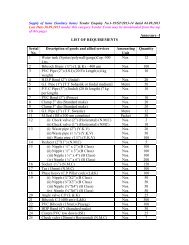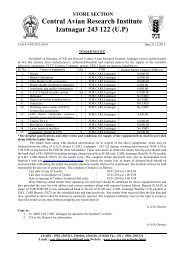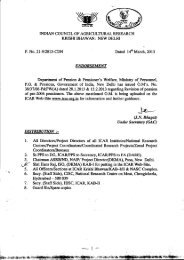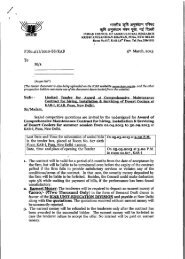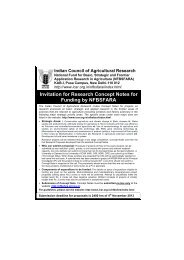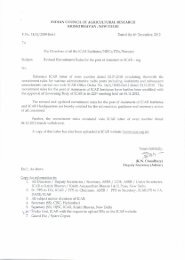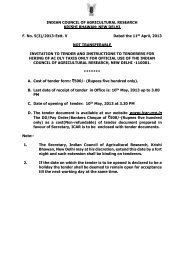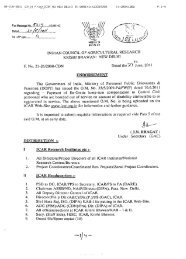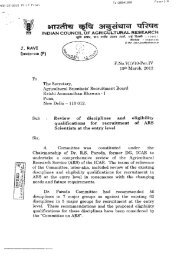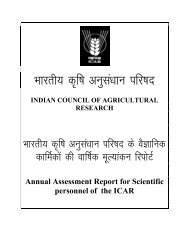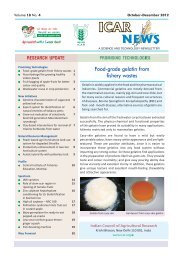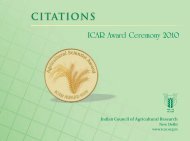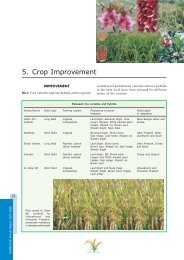agronomy agricultural physics agricultural meteorology soil science
agronomy agricultural physics agricultural meteorology soil science
agronomy agricultural physics agricultural meteorology soil science
Create successful ePaper yourself
Turn your PDF publications into a flip-book with our unique Google optimized e-Paper software.
mates. Agroclimatic indices, agroclimatic zones; different agroecological zones for<br />
India. Climatology of India: Monsoons, length of day, temperature, rainfall and its<br />
variability, atmospheric and <strong>soil</strong> drought. Arid and semi-arid regions. Frequencies of<br />
disastrous weather events in the different regions, Climatological factors and their<br />
effect on crop growth and yield. Climatic change and its causes, global warming,<br />
Bioclimatology: Heat balance of animals, body temperature, inputs.<br />
Suggested Readings<br />
Haurwitz, B. and Austin, J.M. 1944. Climatology. McGraw Hill, Inc., New York,<br />
pp.410.<br />
ICRISAT Climatic classification - A consultants meeting. 1980. ICRISAT-<br />
Hyderabad, India, p. 153.<br />
Lai, D.S., 1989. Climatology. Chaitanya Publishing Home, Allahabad, p.420.<br />
Petterson, S., 1958. Introduction to <strong>meteorology</strong>. McGraw Hill. Inc. New York,<br />
pp.327.<br />
Trewartha, Glenn T. 1954. An Introduction of Climate. McGraw Hill, New York,<br />
pp.395.<br />
3. Micro<strong>meteorology</strong> (2+1)<br />
Properties of atmosphere near the earth's surface. Molecular and eddy transport of<br />
heat, water vapour and momentum, frictional effects, eddy diffusion, mixing. Temperature<br />
instability, air pollution. Microclimate near the bare ground, unstable and<br />
inversion layers, variations in microclimate under irrigated and rainfed conditions,<br />
<strong>soil</strong> moisture and temperature variation with depth. Micro<strong>meteorology</strong> of plant canopies:<br />
Distribution of temperature, humidity, vapour pressure, wind and carbon dioxide.<br />
Modification of microclimate due to cultural practices, intercropping. Radiation<br />
distribution and utilization by plant communities—leaf temperature and its biological<br />
effects. Heat transfer near and within the ground. Influence of topography on<br />
microclimate. Shelter belts and wind breaks, micro climate in low plant area of meadows<br />
and grain fields, microclimate within forests, glass house and plastic house climates.<br />
Instruments and measuring techniques in micro<strong>meteorology</strong>. Effects of ambient<br />
weather conditions on growth, development and yield of crops. Crop-weather<br />
relations, statistical regression equations and crop growth models.<br />
Practical<br />
Measurement of global radiation and diffuse radiation; Measurement of albedo over<br />
natural surfaces and cropped surfaces; Net radiation measurement at different levels;<br />
PAR distribution in plant canopoes and interception; Wind, temperature and humidity<br />
profiles in (a)short crops and (b) tall crops; Energy balance over crops and LAI<br />
and biomass estimation.



